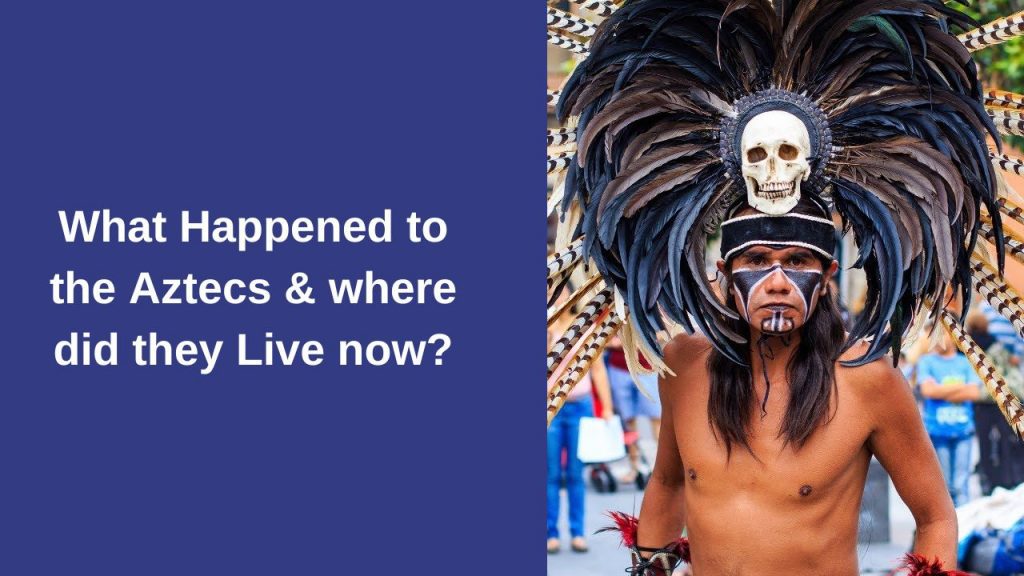Have you heard of the Aztecs? Is that all? Curious to learn more about Aztec people today? The Aztec Empire (1345-1521) dominated northern Mesoamerica.
The military might of the Aztecs allowed its kings, such as Montezuma, to spread Aztec culture and religion throughout Mexico.
The final great Mesoamerican civilisation excelled in agriculture, commerce, and art and architecture.
What did Aztecs do best? The Aztecs were well-known for their land, art, and buildings.
They learned to write, created a calendar, and began constructing religious buildings.
They were notoriously cruel and unyielding, as well. Humans were offered as sacrifices to the gods.
Nonetheless, they possessed remarkable competence and creativity. They used their ingenuity to build an empire and defeat their foes.
Where did the Aztecs live?
Aztecs inhabited the area that is now Mexico. They chose the site of modern-day Mexico City to establish their capital. Their dominion stretched hundreds of kilometers from Mexico City’s foothills (Tenochtitlan) to South America’s jungles.
However, you may be pondering Where did Aztecs get their food? Most Aztecs had mud and straw homes. They had an outdoor garden where they grew their food. You may expect to locate a bed, a kitchen, and a place to worship.
The wealthy lived in stone or brick palaces or mansions. They bathed in saunas and steam chambers.
Many people struggled just to get by because of the wide wealth disparity. While the men fought and farmed, the women raised the children and made clothes. The cloth was used for both men’s capes and women’s gowns.
Now, what will happen to their offspring? How did Aztec kids get by? All Aztec children were required to attend school, just as British youngsters today.
That’s how the law worked! In contrast to the norm at the time, females and enslaved people were required to attend school in this society. Wow, that’s an excellent statute. Is it not?
Different lessons were taught to boys and girls. Men would be taught to hunt and farm, while women would be educated in household arts.
Is there still an Aztec community? Well, sort of. 1.5 million people speak Nahuatl, the Aztec language.
And many native communities still hold ceremonies with clear Aztec roots.
Since “Aztecs” exclusively refers to Tenochtitlan’s “Mexica,” it’s hard to believe there are any aztec people today alive.
However, the Aztec language and cultural practices are unquestionably still flourishing.
In what ways did the Aztecs establish their empire?
Want to know their empire’s secret? This is exactly why we’ve come to inform you. The territory under Aztec rule reached an astounding 80 thousand square miles in Central America. There were millions of subjects under their king.
The Aztecs were originally nomads, or people who did not permanently reside in one location. They were impoverished, so they had to live simple life.
After establishing themselves in Tenochtitlán, they flourished. They had easy access to supplies, food and water, and trading posts in neighboring towns.
The people evolved into powerful warriors who forged partnerships with neighboring communities. As a result, their political influence increased, and they were able to expand their kingdom using conquest.
Sacred Aztec Principles
Like many pre-Columbian American societies, the Aztecs were polytheistic, with deities representing the natural and human realms and controlling weather, harvest, and afterlife.
Their gods frequently took the form of serpents or birds. They thought the five suns had been formed and destroyed at various times.
According to Aztec belief, life existed before people and the fourth sun was killed, after which civilization was established.
What happened to the Aztecs
Aren’t you interested if they survived? Find it here in this answer.
Headaches, high fevers, and bleeding from the mouth, eyes, and nose plagued the Aztec people of Mexico in 1545. After three or four days, most people had already passed away.
Within five years, an epidemic dubbed “cocoliztli” by the natives took off as many as 15 million people or an estimated 80% of the population. Aztec Nahuatl means “plague.” Its origin has been disputed for 500 years.
Like the 14th-century Black Death bubonic plague in Western Europe, this pandemic is anticipated to kill 25 million.
The European settlers who first explored the Americas brought a variety of deadly pathogens to which the native populations had no resistance.
After an initial smallpox outbreak killed an estimated 5–8 million people in the wake of the Spanish conquest, the Cocoliztli plague of 1545 swept through what is now Mexico and a portion of Guatemala.
In a second epidemic that lasted from 1576-1578, another 50 percent of the population perished.
Big ditches were created in the cities and great towns, and the priests’ only job from dawn to dusk was transporting the deceased and disposing of them in the ditches.
Big ditches were created in the cities and large towns, and from dawn to dusk, the priests did nothing except transport the bodies and hurled them in.
Salmonella enterica germs were found in the teeth of cocoliztli victims, according to a study published in Nature Ecology & Evolution on January 15, 2017. Salmonella is a food-borne infection widely known to Americans due to consuming raw poultry or eggs.
Researchers found S. enterica in the teeth of the victims, but they warn that other undetectable infections may also have contributed.
The link between S. enterica and the cocoliztli pandemic remains unproven. We agree that it’s a viable option for consideration.
Is there any veracity to the stories of atrocities like human sacrifices?
Do you know this story? No? Stay with me here.
Spanish colonists wanted to overthrow the Aztec government and start a new colony. Many letters they sent back to Europe tried to explain why they should invade.
The Aztecs and other native peoples were portrayed as savages to rationalize their conduct. Because of this, their accounts of the Aztecs’ brutality are greatly exaggerated.
For instance, one colonial source claims that at the inauguration of one particular Aztec monarch, at least 80,000 individuals were sacrificed. In other words, it would be an improbable scenario if 15 people were killed every minute for four days.
The Spanish used allegations like this in their propaganda to justify the invasion. Human remains were unearthed beyond a doubt in the area surrounding the Aztec temple known as the Templo Mayor.
These may have been executed Tenochtitlan residents or battle prisoners. The amount of skeletons found is consistent with the deaths of a few hundred people, not the thousands upon thousands as were suggested by the Spanish.
Do we understand Aztecs fully?
Every day, researchers in Mexico City unearth something new. Archaeologists’ digging continues to produce stunning discoveries surrounding the Templo Mayor. Much is still unknown about Aztec culture.







